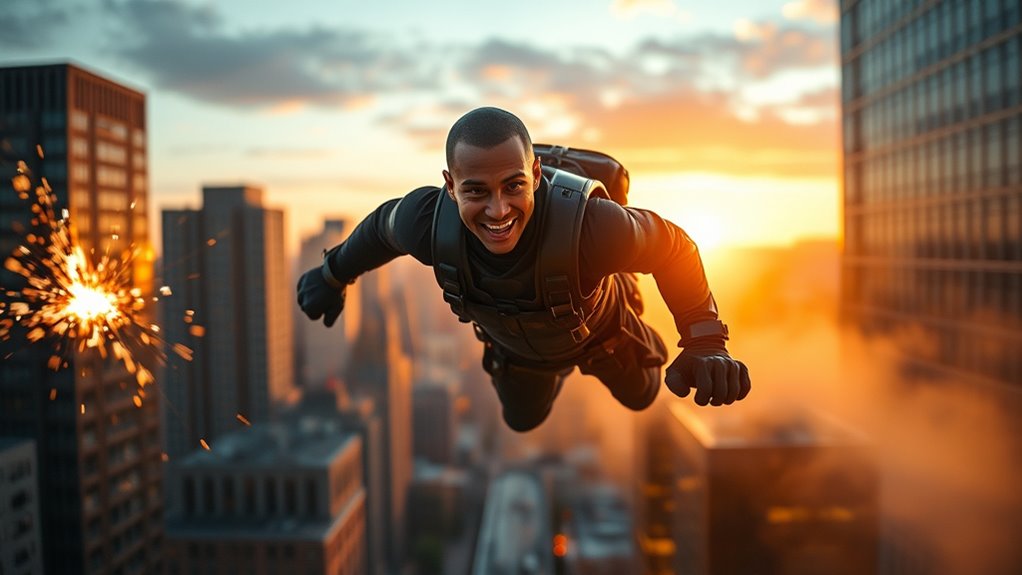In “The Stunt Double Diaries,” you see how stunt doubles keep TV heroes safe during dangerous scenes. They perform risky moves with precision, backed by careful planning and safety gear like padded costumes. Their role involves choreographing action sequences, ensuring costumes allow full motion, and working closely with coordinators to minimize danger. If you want to discover how these professionals turn high-risk moments into safe, engaging action, there’s more to uncover just ahead.
Key Takeaways
- Stunt doubles perform risky scenes while prioritizing safety through skill, choreography, and safety gear.
- Costume design incorporates protective features like padding to prevent injuries during stunts.
- Stunt coordinators meticulously plan, rehearse, and assess risks to ensure safe execution of complex scenes.
- Proper communication and teamwork enable quick adaptations, maintaining safety during high-risk performances.
- Combining skill, costume safety features, and thorough planning results in convincing yet secure TV action scenes.

Behind every daring action scene, there’s a stunt double risking their body so the star can shine. You might never see their face, but without their skill and dedication, those heart-stopping moments wouldn’t be possible. As a stunt double, your job isn’t just about performing dangerous moves; it’s also about guaranteeing every detail, from costume design to stunt coordination, works seamlessly to keep you safe. The costume you wear isn’t just about looking the part—it’s about functionality and protection. You rely on carefully designed costumes that incorporate padding, flexible materials, and safety features without sacrificing authenticity. These costumes must look authentic on screen but also allow you full range of motion, so every flip, jump, or fight feels natural and safe. Understanding costume safety features helps prevent injuries during high-risk stunts.
Stunt coordination is the backbone of every high-risk scene. As a stunt performer, you depend on a team of specialists who plan each move meticulously. They break down complex sequences, assess risks, and choreograph actions to minimize danger. It’s their job to know exactly how you’ll land that fall or execute that fight, and to have backup plans in case something goes awry. Effective stunt coordination involves rehearsing extensively before filming begins, ensuring everyone is clear on their roles and safety protocols. You’re trained to follow these plans precisely, trusting that the coordination behind the scenes is working to protect you. This teamwork creates a safety net that allows you to push your limits without unnecessary risk.
Your understanding of costume design and stunt coordination is vital in executing convincing, safe performances. When you’re in the middle of a fight scene, your costume’s fit and safety features help prevent injuries, while your knowledge of choreography ensures your movements are precise and controlled. You must adapt quickly if something doesn’t feel right, communicating with stunt coordinators and costume designers to make adjustments. Your awareness of how each element – from the costume to the choreography – interacts keeps you safe. The trust you develop with the team allows you to perform daring stunts with confidence, knowing that every safety measure is in place. In the end, your skill, combined with meticulous planning and thoughtful costume design, transforms risky moments into seamless, safe action that keeps viewers on the edge of their seats.
Frequently Asked Questions
How Do Stunt Doubles Memorize Complex Fight Choreography?
You memorize complex fight choreography by breaking it down into manageable sections, using effective training techniques like repetition and slow practice. You rely on memorization strategies such as mental visualization and cue-based drills to reinforce moves. Consistent repetition helps embed each step into your muscle memory, and practicing with a partner or mirror guarantees you stay on cue. Over time, these methods make complex routines feel natural and instinctive.
What Safety Gear Do Stunt Doubles Typically Wear?
You wear safety harnesses to prevent falls, fire-resistant costumes to protect against flames, and helmets to shield your head. You also use pads to cushion impacts, gloves for grip and hand protection, and mouthguards to protect your teeth. These gear pieces work together to keep you safe during daring stunts, allowing you to perform confidently while minimizing risks and ensuring your well-being throughout the action.
How Do Stunt Doubles Coordinate With Special Effects Teams?
You coordinate with the special effects team during stunt double rehearsals to guarantee seamless integration. By discussing safety measures and timing in advance, you prevent mishaps. During filming, you stay in close contact, adjusting actions as needed to match effects. This collaboration helps execute complex scenes smoothly, ensuring everyone’s safety. Effective special effects coordination makes stunts look realistic while minimizing risks for the stunt double and crew.
What Training Is Required to Become a Stunt Double?
Imagine stepping into a superhero’s shoes—your training begins there. You’ll need to pass rigorous stunt double auditions, demonstrating skills like fight choreography, fall techniques, and high-speed driving. Training also covers safety protocols, physical fitness, and stunt-specific insurance knowledge. Certifications in CPR and first aid are often required, ensuring you’re prepared for emergencies. This extensive preparation helps you perform confidently while protecting yourself and others on set.
How Are Stunt Doubles Protected From Legal Liabilities?
You’re protected from legal liabilities as a stunt double through extensive insurance coverage and signed liability waivers. Insurance covers potential injuries, while liability waivers release producers from certain legal claims. By carefully reviewing these documents and ensuring proper coverage, you reduce your risk of legal issues. Always work with legal professionals to verify your protection measures, so you can focus on performing your stunts safely and confidently.
Conclusion
So, next time you watch your favorite hero leap from rooftops or battle villains, remember, a stunt double is risking it all—literally defying gravity and dodging disaster. They’re like superheroes in disguise, twisting through flames and smashing through walls just to keep the story alive. Without them, your TV world would collapse in a cloud of chaos. So, tip your hat to these fearless daredevils—because without them, your favorite scenes would be history in the making!










